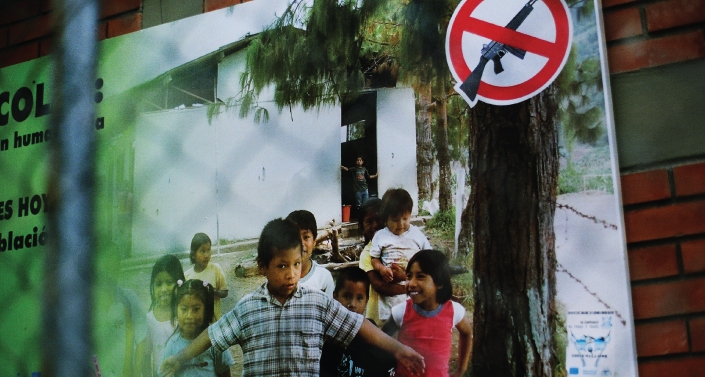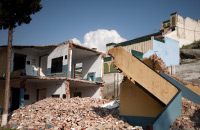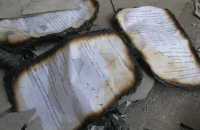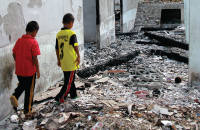Attacks on education are any intentional threat or use of force—carried out for political, military, ideological, sectarian, ethnic, religious, or criminal reasons—against students, educators, and education institutions.
Protecting Schools and Universities from Military Use

The use of schools and universities by armed forces and armed groups for military purposes during situations of armed conflict can disrupt or completely deny education in both the immediate and long terms.
Government security forces and non-state armed groups are often attracted by the location, solid structure, and ready facilities found in schools, universities, and other education institutions. They have used these sites in a variety of ways, including as military bases, shelters, weapons caches, and outposts, with their use lasting weeks, months, and even years. Such military use not only seriously disrupts students’ learning, it also provokes attacks from opposing forces.
In the majority of countries with armed conflicts, armed forces or armed groups use schools and other education institutions. Between 2005 and 2015, they used education institutions in conflicts in at least 26 countries: Afghanistan, Burma / Myanmar, Central African Republic, Chad, Colombia, Côte d’Ivoire, Democratic Republic of Congo, Georgia, India, Iraq, Libya, Mali, Nepal, Nigeria, Occupied Palestinian Territory/Israel, Pakistan, Philippines, Somalia, South Sudan, Sri Lanka, Sudan, Syria, Thailand, Uganda, Ukraine, and Yemen.
Such use can result in:
- Long-term school closures
- Displacement of students to schools away from their home communities
- Declines in student attendance, enrollment, and transitions to higher levels
- Declines in availability of teachers
- Attacks by opposing parties and destruction and damage of education infrastructure
- Psychosocial impacts on students, teachers, and communities
- Disproportional impacts on female students and teachers and on marginalized groups
Restricting the use of education institutions by militaries and armed groups is critical for ensuring that education continues during and after conflict. The initiative is intended to build global recognition of the negative consequences of military use of schools and universities, and the need – and commitment – to restrict the practice.
In May 2015, the Coalition released Lessons in War 2015: Military Use of Schools and Universities in Armed Conflict, an updated version of its November 2012 which sets out how armed forces and non-state armed groups used schools and universities as bases, barracks, weapons caches, firing ranges, and interrogation and detention centers in most conflicts around the world in the last seven years. It also described the deadly consequences of this practice, including converting education facilities into legitimate military targets under international law, and the resultant risk of students being caught in attacks by opposing forces.
In 2012, GCPEA held two expert consultations with representatives from governments, militaries, UN agencies, and international humanitarian and human rights organizations, some of which have direct and indirect contact with non-state actors, to discuss how to address military use of schools and universities. At the first meeting, held in Geneva in May, participants recognized the need for clear international guidelines setting out recommendations for minimizing military use of education institutions. In response, GCPEA commissioned a former British military commander to prepare draft guidelines based on input from the consultation. This draft was reviewed at a second expert consultation with wider participation, including representation from 12 states, at the Château de Lucens in Switzerland in November. A preliminary version of the guidelines resulted from deliberations at this meeting and was subsequently revised by a drafting committee comprised of state representatives. as well as other experts.
In June 2013, GCPEA released the Draft Lucens Guidelines for Protecting Schools and Universities from Military Use during Armed Conflict and a year later, the Norwegian government announced its commitment to lead states in finalizing, endorsing, and implementing the Guidelines. In December 2014, the final Guidelines for Protecting Schools and Universities from Military Use during Armed Conflict were unveiled at a meeting hosted by the Missions of Norway and Argentina at the UN in Geneva. Throughout the first half of 2015, Norway and Argentina led consultations to develop the Safe Schools Declaration, through which states can express political support and commitments for the protection of education in armed conflict, including through the implementation of the Guidelines. The Safe Schools Declaration was endorsed by an initial group of 37 states at an international conference on Safe Schools in Oslo on May 29, 2015 and that number has since been growing.
On March 28-29, 2017, the Argentine ministries of foreign affairs and defense co-hosted the Second International Safe Schools Conference in Buenos Aires. GCPEA, in partnership with the Romeo Dallaire Child Soldiers Initiative, released a Toolkit on implementing the Guidelines for Protecting Schools and Universities from Military Use During Armed Conflict at the Conference.
States can confirm their endorsement at any time by sending an endorsement letter to the Norwegian Ministry of Foreign Affairs via its embassies or permanent missions or directly at Seksjon.for.humanitaere.sporsmal@mfa.no. States can also announce their endorsement by making a public announcement during a formal meeting in a multilateral forum, followed by a written endorsement issued to Norway according to the same procedure.
Click here to see which states have already endorsed the Safe Schools Declaration.
To learn more about the Safe Schools Declaration and the Guidelines please click here.
This video is also available in:
Arabic, Dutch, French, German, Japanese, Norwegian, and Spanish
To see videos of Voices in Support of the Safe Schools Declaration, click here.
For further information please see:
Lessons in War 2015: Military Use of Schools and Universities in Armed Conflict (GCPEA, 2015)
[Arabic] [French] [Spanish]
Executive summary: [French] [Spanish]
Protect Schools and Universities from Military Use (GCPEA, 2013)
Education Under Attack 2014: Thematic Essay on military use of schools and universities (GCPEA, 2014)
Guidelines for Protecting Schools and Universities from Military Use during Armed Conflict
[Arabic] [Bosnian] [Burmese] [Chinese] [Croatian] [Dari] [Dutch] [Estonian] [French] [Hindi] [Japanese] [Korean] [Latvian] [Lithuanian] [Malay] [Nepali] [Portuguese] [Russian] [Serbian] [Slovak] [Somali] [Sorani] [Spanish] [Swahili] [Thai] [Turkish] [Ukrainian] [Urdu] [Vietnamese]
Safe Schools Declaration
[Arabic] [Bosnian] [Burmese] [Chinese] [Croatian] [Dari] [Estonian] [French] [Hindi] [Japanese] [Korean] [Latvian] [Lithuanian] [Malay] [Nepali] [Portuguese] [Russian] [Serbian] [Slovak] [Somali] [Spanish] [Swahili] [Thai] [Turkish] [Ukrainian] [Urdu] [Vietnamese]
Commentary on the "Guidelines for Protecting Schools and Universities from Military Use during Armed Conflict (GCPEA, 2015) [Arabic] [French] [Russian] [Spanish] [Ukrainian]
The Problem
Attacks on education violate the right to education and other internationally protected human rights applicable at all times.
Attacks on students, educators, and education institutions can have a devastating impact on access to education and education systems and on a society’s overall development in the long-term.




